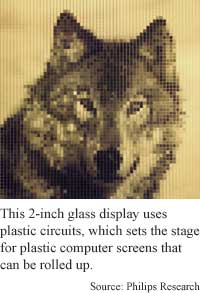
E-paper
coming into view
By
Kimberly Patch,
Technology Research NewsWe've been hearing about electronic paper and how useful it will be for more than a decade now.
Scientists at Philips Research in the Netherlands have pushed the electronic paper chase a big step forward with a prototype two-inch active matrix display that depicts high-contrast text, and gray-scale pictures.
The electronic components of the display are organic materials flexible enough to eventually be embedded in sheets of plastic two-tenths of a centimeter thick, said Edzer Huitema, a senior scientist at Philips research in the Netherlands.
The 4,096-pixel prototype, which is made of glass, can depict fairly detailed images using 256 shades of gray.
The electronics are also fairly low-cost, said Huitema. "It is low-cost because we use very simple processing from solution. Only simple equipment is needed and processing temperatures are low," he said.
The researchers are working on putting the electronics into large sheets of plastic that can be used as roll-up displays, said Huitema. "This is just like rolling up the newspaper after reading it on the train. It will be small when carried and large when used for reading," he said.
The two keys to the quality of the image are a high refresh rate and a high contrast ratio. The refresh rate is as high as 100 Hz, which means the information on the screen is repainted 100 times a second; this is fast enough that the human eye sees no flicker, and more than fast enough to support video.
The screen has a contrast ratio of 8.6, which is high for a low-power display that uses no back light, said Huitema. The contrast ratio is comparable to that a black ink on paper, and better than that of ink on newsprint, he said. The contrast in the Wall Street Journal, for example is 5.3, he said. The contrast ratio is the amount of light reflected into the eye when it is looking at a white pixel divided by the amount of light reflected into the eye when the pixel is black.
In April, Bell Labs researchers demonstrated an electronic paper prototype made of flexible plastic that had an even higher contrast ratio, but it was black and white rather than grayscale, had only 256 pixels and took a full second to refresh.
The flexible electronics that make up the active part of the Philips display are similar to the electronics that make up the active matrix displays found in many computers today, except they are made of plastic instead of silicon.
Varying the amounts of electrical current coursing through each pixel causes the liquid crystalline material it contains to react, changing the look of the pixel. "At low voltages... the liquid crystalline material is hardly switched, resulting in a white pixel. At intermediate voltages it is halfway switched, resulting in a gray pixel. And at high voltages the liquid crystalline material is fully aligned in the electric field, resulting in a black pixel," said Huitema.
The challenge was making the transistors that guide electric current of plastic rather than silicon. The polymer semiconductor material they used consists of thousands of strands of connected molecules that form a layer 50 to 100 microns thick. "The semiconductor can be depicted as a big pile of spaghetti," said Huitema.
The researchers put together the display by covering the glass with a layer of gold, an insulating layer, and another layer of gold to form electrodes. On top of these layers, they put a layer of the plastic semiconductor material, then used photolithography to pattern the semiconductor into transistors. Photolithography uses light and chemicals to pattern shapes. To protect the semiconductors, they added a second coating of a different kind of plastic.
To sandwich the active matrix layer, they added an indium tin oxide layer to the back of the screen and filled the display with liquid crystals.
Because the semiconductor layer starts out as a solution, the researchers may eventually be able to use printing technology to form and place the plastic transistors rather than the more expensive photolithography methods, said Huitema. "If it is possible to print it in the future [there's] an additional cost advantage," he said.
It will take about five years before the technology is ready for commercial use, said Huitema.
Huitema's research colleagues were Gerwin Gelinck, Bas van der Putten, Karel Kuijk, Cees Hart, Eugenio Cantatore and Dago de Leeuw from Philips Research, and Peter Herwig and A. J. J. M. van Breemen of the Netherlands Organization for Applied Scientific Research. They published the research in the December 6, 2001 issue of Nature. The research was funded by Philips and the European Union.
Timeline: > 5 years
Funding: Corporate, Government
TRN Categories: Semiconductors; Integrated Circuits
Story Type: News
Related Elements: Technical paper, "Plastic Transistors in Active-Matrix Displays," Nature, December 6, 2001.
Advertisements:
December 12, 2001
Page One
E-paper coming into view
Semiconductors control quantum spin
Cold electrons crystallize
Neat not always organized
Single molecule drives transistor

News:
Research News Roundup
Research Watch blog
Features:
View from the High Ground Q&A
How It Works
RSS Feeds:
News
Ad links:
Buy an ad link
| Advertisements:
|
 |
Ad links: Clear History
Buy an ad link
|
TRN
Newswire and Headline Feeds for Web sites
|
© Copyright Technology Research News, LLC 2000-2006. All rights reserved.